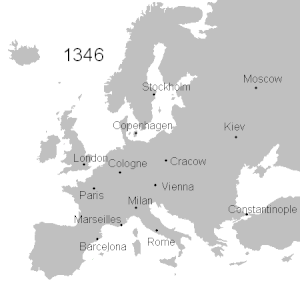Black Daith

The Black Daith wis ane o the maist devastating pandemics in human history, resultin in the daiths o an estimatit 75 tae 200 million fowk in Eurasie an peakin in Europe in the years 1346–1353.[1][2][3] Awtho thare war several competin theories as tae the etiology o the Black Daith, analyses o DNA frae victims in northren an soothren Europe published in 2010 an 2011 indicates that the pathogen responsible wis the Yersinia pestis bacterium, probably causin several forms o plague.[4][5]
The Black Daith is thocht tae hae oreeginatit in the dry plains o Central Asie, whaur it traivelled alang the Silk Road, reachin Crimea bi 1343.[6] Frae there, it wis maist likely cairied bi Oriental ratton flechs leevin on the black rats that war regular passengers on merchand ships, spreidin ootthrou the Mediterranean Basin an Europe.
The Black Daith is estimatit tae hae killt 30–60% o Europe's tot population.[7] In tot, the plague mey hae reduced the warld population frae an estimatit 450 million doun tae 350–375 million in the 14t century.[8] It teuk 200 years for the warld population tae rekiver tae its previous level.[9][10] The plague recurred as ootbraks in Europe till the 19t century.
References
[eedit | eedit soorce]- ↑ ABC/Reuters (29 Januar 2008). "Black death 'discriminated' between victims (ABC News in Science)". Australian Broadcasting Corporation. Retrieved 3 November 2008.
- ↑ "Health. De-coding the Black Death". BBC. 3 October 2001. Retrieved 3 November 2008.
- ↑ "Black Death's Gene Code Cracked". Wired. 3 October 2001. Retrieved 12 Februar 2015.
- ↑ Haensch S, Bianucci R, Signoli M, Rajerison M, Schultz M, Kacki S, Vermunt M, Weston DA, Hurst D, Achtman M, Carniel E, Bramanti B (2010). Besansky, Nora J (ed.). "Distinct clones of Yersinia pestis caused the black death". PLoS Pathog. 6 (10): e1001134. doi:10.1371/journal.ppat.1001134. PMC 2951374. PMID 20949072.CS1 maint: uises authors parameter (link)
- ↑ Bos KI, Schuenemann VJ, Golding GB, Burbano HA, Waglechner N, Coombes BK, McPhee JB, DeWitte SN, Meyer M, Schmedes S, Wood J, Earn DJ, Herring DA, Bauer P, Poinar HN, Krause J (12 October 2011). "A draft genome of Yersinia pestis from victims of the Black Death". Nature. 478 (7370): 506–10. doi:10.1038/nature10549. PMC 3690193. PMID 21993626.CS1 maint: ref=harv (link)
- ↑ "BBC – History – Black Death". BBC. 17 Februar 2011.
- ↑ Austin Alchon, Suzanne (2003). A pest in the land: new world epidemics in a global perspective. University of New Mexico Press. p. 21. ISBN 978-0-8263-2871-7.
- ↑ "Historical Estimates of World Population". Census.gov. Retrieved 12 November 2016.
- ↑ Wheeler, Dr. L. Kip. "The Black Plague: The Least You Need to Know". Dr. Wheeler's website. Dr. L. Kip Wheeler. Retrieved 9 August 2015.
- ↑ Jay, Peter (17 Julie 2000). "A Distant Mirror". TIME Europe. 156 (3). Archived frae the original on 25 Julie 2008. Retrieved 25 Januar 2018.
